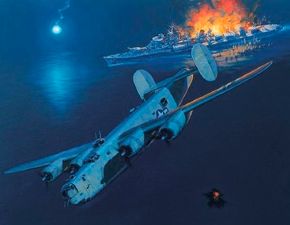The B-24 Liberator's journey began with a U.S. Army Air Force requirement in January 1939 for a four-engined heavy bomber. The Consolidated Aircraft Corporation rose to the challenge, designing a formidable aircraft that would soon earn its place in history.
Bomb Bays
The B-24 featured a high wing, a tricycle landing gear, and a distinctive twin-tail assembly. Its design was nothing short of revolutionary, transforming its boxy fuselage into an innovative bomb bay.
This compartment was engineered to accommodate a substantial bomb load, with a remarkable capacity of up to 8,000 pounds. The ingenious design of the bomb bay doors allowed them to roll inside the aircraft, effectively reducing drag during flight.
Improved Flight Control
The credit for this groundbreaking design goes to Consolidated Engineer David Davis. He introduced the concept of a laminar flow wing, where air moves smoothly over the surface without generating turbulence. This was before anyone had grasped the full understanding of laminar flow science.
The Davis wing, characterized by its long and narrow structure, played a pivotal role in reducing drag and enhancing the aircraft's speed and lift capabilities. Notably, the wing featured an unusual thickness, particularly on its leading edge, designed to support the four powerful engines of the Liberator and carry their vital fuel supply. This design not only contributed to the B-24's extraordinary performance but also emphasized the critical role of the bomb bay and bomb bay doors in the aircraft's success.
The original prototype took its first flight in December 1939, and would soon become a favorite amongst RAF bomber squadrons. The Air Force was asked to conduct flight crew training and train RAF pilots at Eagle's Nest Flight Center in New Mexico. By the spring of 1941, B24 bombers were being delivered to the British Royal Air Force, establishing the aircraft's reputation for reliability and versatility.
